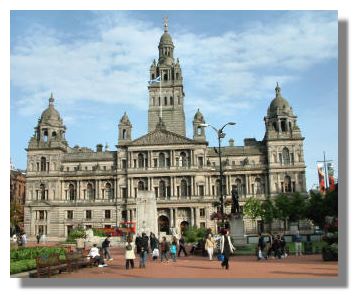
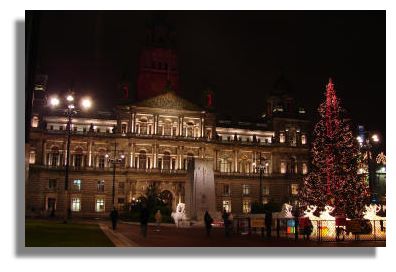
These days, George Square hosts many events throughout the year, from Art Fairs to pop concerts. And over the festive season, Christmas lights and a large tree from Norway brighten up the short days of winter. The square also fills up with revellers every New Year's Eve as thousands celebrate the traditional Hogmanay.
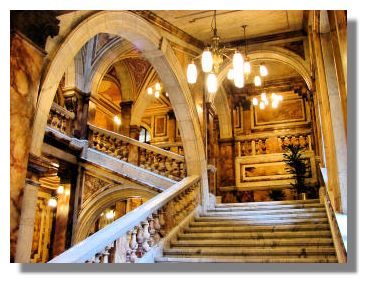
Glasgow City Chambers was built in the 1880s, at a time when at least some of Glasgow's citizens had become very wealthy through trade and industry. They were proud of its positions a the "second city of the Empire" after London and Glasgow City Council decided to create a home for itself that would reflect its status. They launched a design competition and the winner was William Young, a London-based architect whose grandiose design impressed the city fathers. Young had spent time in Italy and his design incorporated many classical Italian features. 600,000 people gathered to watch the laying of the foundation stone on 6 October 1883. Five years later, Queen Victoria performed the formal opening.
No expense had been spared and the main staircase (seen here) is solid Carrara marble for three floors of the building. The wall panels are made of alabaster. The original budget had been £150,000 but that rose to £578,232 (some things never change). The original building provided 53,000 square feet of usable space. (Since then, extensions running back from the main building have expanded that to 150,000 square feet). When it opened, it was one of the first buildings in the country to be lit by electricity.
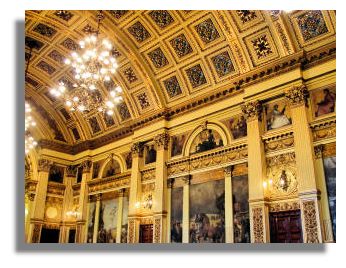
The main banqueting hall is used for civic functions and formal events but also hosts charitable events, children's parties and even fashion shows. It is 110 feet long by 48 feet wide and the ornate ceiling, covered in paintings and gold leaf, is 52 feet high. The walls are decorated with murals showing some of the history of the city. The artists were from the famous "Glasgow School" including Sir John Lavery, Alexander Roche and George Henry.
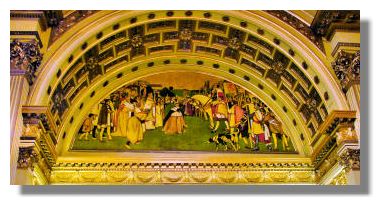
The mural at the far end of the banqueting hall depicts the granting of the city's charter by King William the Lion of Scotland, around 1175. It was the establishment of a church in Glasgow which was elevated to the status of a cathedral in 1114 that gave Glasgow its importance in the early days. The granting of the burgh charter gave it the right to hold a weekly market and an annual fair - still celebrated as the "Glasgow Fair" holiday in the middle of July.
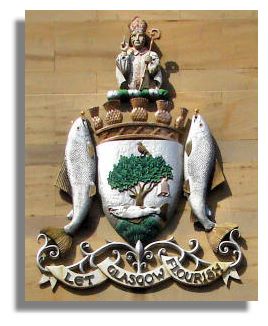
In 1866 the Lord Lyon King at Arms gave approval for a coat of arms for the City of Glasgow which incorporated a number of symbols and emblems which had been used on official seals up until then - all of which were associated with St Mungo. Many people, including Glaswegians themselves, are only vaguely aware of the stories and legends associated with the coat of arms:
There's the tree that never grew,
There's the bird that never flew,
There's the fish that never swam,
There's the bell that never rang.
See Did You Know - Glasgow's Coat of Arms for the explanation of the symbols plus more information and illustrations.
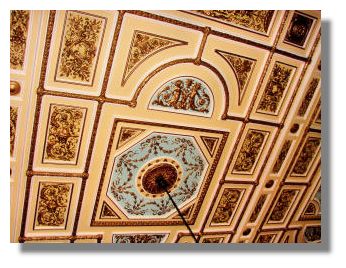
The Satinwood Suite is lined with satinwood imported from Queensland, a type of wood that is no longer available. As you can see, there is another magnificent ceiling and there are smaller-scale paintings on the walls on each side of a huge alabaster fireplace.
The Satinwood Suite is next door to the main council debating chamber. Unlike the other rooms we visited, the dark mahogany wood and stained glass windows and low lighting levels there meant that it was not possible to take decent photographs. The lack of light and clarity seemed somewhat symbolic ....
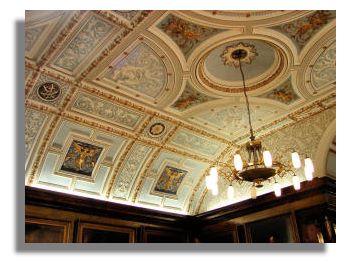
Climbing those stairs again, we reached the Upper Gallery which is lined with portraits of Lord Provosts (roughly equivalent to Lord Mayor) of Glasgow going back to the 19th century (although the earliest Lord Provost is recorded as far back as 1450 - see the list at Wikipedia). Until more recent times, they are oil paintings of austere dignitaries, but the more recent portraits are a mixture of photographs and modern paintings.
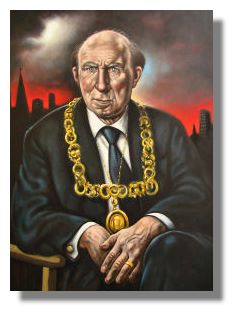
One of the portraits is by Peter Howson of Pat Lally, a colourful character who was Lord Provost from 1996-1999, although he was involved in local government politics from 1966 to 1999. He was credited as the driving force behind civic successes such as the 1988 Glasgow Garden Festival, Glasgow becoming European City of Culture in 1990, and European City of Architecture in 1999. He was also played an important role in the creation of the Glasgow Royal Concert Hall, which is sometimes dubbed 'Lally's Palais'. His political career was sometimes a stormy one and had its ups and downs. But he kept returning to power, so earning the nickname of "Lazarus".
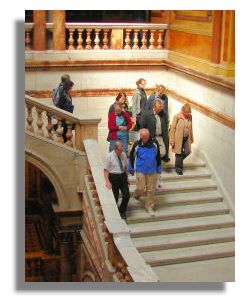
The 45 minutes to an hour-long free tours of the Glasgow City Chambers are available most weekdays at 10.30am and 2.30pm. For up-to-date details, see Glasgow City Council Web site.



